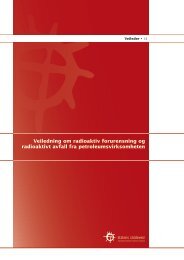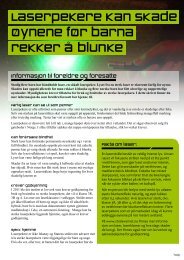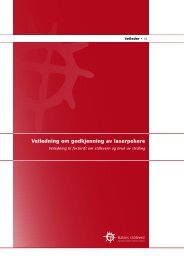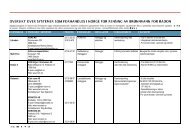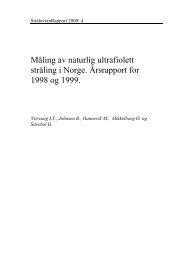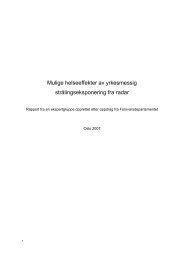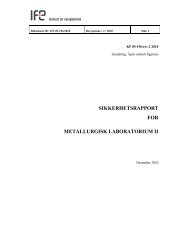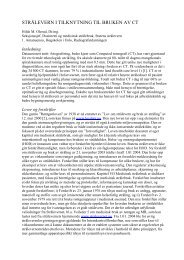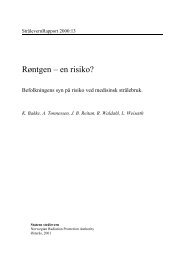Indoor Tanning in Norway - Statens strålevern
Indoor Tanning in Norway - Statens strålevern
Indoor Tanning in Norway - Statens strålevern
Create successful ePaper yourself
Turn your PDF publications into a flip-book with our unique Google optimized e-Paper software.
1 <strong>Indoor</strong> tann<strong>in</strong>g<br />
<strong>Indoor</strong> tann<strong>in</strong>g has become widely used <strong>in</strong><br />
many countries dur<strong>in</strong>g the recent two decades.<br />
A register of tann<strong>in</strong>g facilities were established<br />
<strong>in</strong> 2004 <strong>in</strong> <strong>Norway</strong>, and so far more than 1100<br />
facilities (tann<strong>in</strong>g saloons, fitness centres,<br />
hotels, hair dressers and at workplaces) and<br />
several thousand sunbeds have been reported.<br />
In addition, an unknown number of sunbeds<br />
exist <strong>in</strong> private homes. Regulations and<br />
recommendations regard<strong>in</strong>g <strong>in</strong>door tann<strong>in</strong>g<br />
exist <strong>in</strong> a dozen countries <strong>in</strong> addition to<br />
<strong>Norway</strong>, as described <strong>in</strong> a recent expert report<br />
on exposure to artificial UV (ultraviolet)<br />
radiation and sk<strong>in</strong> cancer from IARC (1). Use<br />
of <strong>in</strong>door tann<strong>in</strong>g is more common among<br />
women, particularly among younger age<br />
groups and <strong>in</strong> the Northern countries. <strong>Indoor</strong><br />
tann<strong>in</strong>g is also frequently used by those with a<br />
poor tann<strong>in</strong>g ability, i.e. sk<strong>in</strong> types I and II.<br />
This is <strong>in</strong> contrast to conclusions from<br />
<strong>in</strong>ternational authorities like World Health<br />
Organization (WHO), the International<br />
Commission on Non-Ioniz<strong>in</strong>g Radiation<br />
Protection (ICNIRP), EUROSKIN and the<br />
Scientific Committee on Consumer Products<br />
(SCCP) that have advised aga<strong>in</strong>st use of<br />
sunbeds for adolescents and those with a low<br />
ability to tan (3-6). SCCP has also suggested<br />
str<strong>in</strong>gent European regulations regard<strong>in</strong>g use<br />
of tann<strong>in</strong>g devices and with strict UV<br />
irradiance limits.<br />
Estimates from a Swedish study (26) show that<br />
on a population level, UV exposure to the sk<strong>in</strong><br />
from artificial UV sources could be of the<br />
same order of magnitude as from the sun.<br />
Excessive tann<strong>in</strong>g is associated with adverse<br />
health effects. Immediate effects <strong>in</strong>clude<br />
sunburn, phototoxic and photoallergic<br />
reactions and eye damage, while late effects<br />
<strong>in</strong>clude sk<strong>in</strong> ag<strong>in</strong>g and sk<strong>in</strong> cancer (1, 2, 20).<br />
Exposure to sunbeds, and <strong>in</strong> particular, first<br />
exposure to sunbeds before 35 year of age<br />
significantly has been shown to <strong>in</strong>crease the<br />
risk of cutaneous malignant melanoma (1, 2,<br />
21-23). On the positive side, exposure to the<br />
sun <strong>in</strong>itiates the synthesis of vitam<strong>in</strong> D <strong>in</strong> the<br />
sk<strong>in</strong> (11, 25).<br />
Over time, the spectral characteristics from<br />
<strong>in</strong>door tann<strong>in</strong>g devices have shifted from<br />
predom<strong>in</strong>antly UVB (280-315 nm) to UVA<br />
(315-400 nm), and then to UVA comb<strong>in</strong>ed<br />
with <strong>in</strong>creas<strong>in</strong>g amounts of UVB (1-2, 7-19).<br />
As regards sk<strong>in</strong> cancer, UVB is important for<br />
squamous cell carc<strong>in</strong>oma development, but<br />
both UVB and UVA may play a role for<br />
cutaneous malignant melanoma and basal cell<br />
carc<strong>in</strong>oma. More knowledge is needed<br />
concern<strong>in</strong>g the action spectrum (1, 2, 24).<br />
Experimental models mimick<strong>in</strong>g the <strong>in</strong>duction<br />
of sk<strong>in</strong> cancer are still not satisfactory,<br />
therefore epidemiological studies are<br />
important. In particular, it is important to<br />
consider the time periods when these devices<br />
have been used with respect to UVB and UVA<br />
irradiances and the ratio between them.<br />
<strong>Norway</strong>, together with Sweden, was among the<br />
first countries to implement national<br />
regulations for <strong>in</strong>door tann<strong>in</strong>g devices (28, 31).<br />
The first regulation appeared <strong>in</strong> 1983, and the<br />
irradiance limits changed to comply with the<br />
European Standard (36) <strong>in</strong> the autumn 1992.<br />
The European Standard sets technical<br />
requirements for the tann<strong>in</strong>g devices, but only<br />
a few countries regulate the use of these<br />
devices.<br />
This report presents regulations of <strong>in</strong>door<br />
tann<strong>in</strong>g <strong>in</strong> <strong>Norway</strong> from 1983 to 2005,<br />
<strong>in</strong>clud<strong>in</strong>g approval of tann<strong>in</strong>g devices and<br />
results from two <strong>in</strong>spection surveys (1998 and<br />
2003). Approval and <strong>in</strong>spection data provides a<br />
unique opportunity to assess UV irradiance due<br />
to <strong>in</strong>door tann<strong>in</strong>g devices <strong>in</strong> use dur<strong>in</strong>g this<br />
period. Comparisons with irradiance of natural<br />
sun are also performed. The report also forms<br />
the basis to assess changes <strong>in</strong> compliance with<br />
regulations over time.<br />
UV wavelength regions<br />
UVC 100 - 280 nm<br />
UVB 280 - 315 nm<br />
UVA 315 - 400 nm<br />
UV wavelength regions accord<strong>in</strong>g to the<br />
European Standard<br />
Short wave UV 250 - 320 nm<br />
Long wave UV 320 - 400 nm<br />
9



